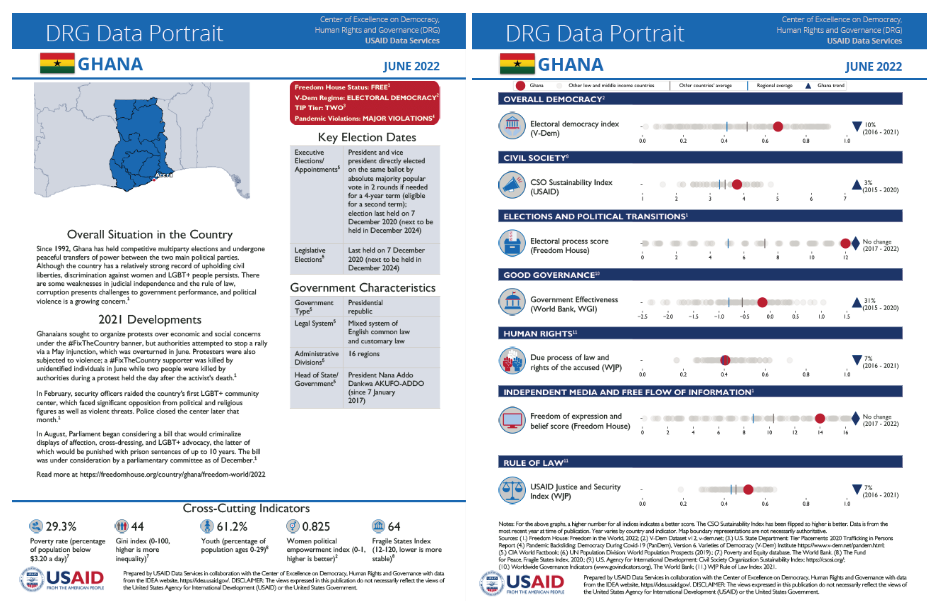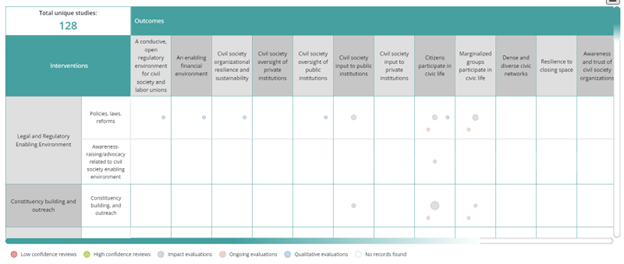|
Making high-quality evidence and analysis easier to access is key to fulfilling USAID’s commitment to improving evidence-based decision making and advancing a culture of learning. The Center for Democracy, Human Rights, and Governance (DRG) recognizes that DRG professionals face a perennial bandwidth challenge which limits their ability to search for relevant analytical resources. To address this challenge, the Center launched the Learning, Evidence, and Analysis Platform (LEAP), a curated set of DRG-related resources that USAID officers and implementing partners can use throughout the Program Cycle to improve DRG program outcomes.
This edition of the DRG Learning Digest introduces the platform, its resources, and their organization around the following topics:
-
Where to Start: Become more familiar with the latest metrics available to help practitioners understand a country’s DRG context and measure an intervention’s impact.
-
Finding Inspiration: Search the compilation of USAID’s approaches to DRG programming.
-
Evidence: Dig into the resources regarding the efficacy of DRG programmatic approaches.
And please make use of DRG Evidence and Learning (E&L) Team resources! (See text box at the end.)
Where to Start: Metrics to Inform and Evaluate Programs
The starting point for most DRG practitioners in the strategy or activity design process is assessing the challenges and opportunities that exist in a country or sector against a desired endstate. The Center has identified and compiled key metrics for understanding and measuring DRG concepts. These include Country Data Portraits, a Third Party Indicators Database, and a Program Indicators Database. Coming soon, the metrics component will also contain a survey repository.
Country Data Portraits. The Country Data Portraits are a collection of two-page summaries of country-level DRG data. Each country has portraits for DRG overall and for DRG subsectors. The country’s DRG Data Portrait contains a narrative summary of the state of DRG in the country, recent developments and trends, a snapshot of political and legal systems and the current status for key indicators, and graphs showing indicators compared to similar countries. Similarly, subsector-specific portraits for each country dig deeper into the subsector’s development, relevant systems, and key indicators with graphs showing indicators over time. Country Data Portraits help practitioners quickly understand the DRG situation in a country and provide context and comparison across DRG subsectors. They are especially useful to review when taking on a new assignment, to supplement concept or portfolio reviews, before going on TDY, or to share with colleagues who aren't familiar with DRG issues in a country.
 Overall DRG Data Portrait for Ghana
Third Party Indicator Database. Beyond what is possible to capture in the Country Data Portrait, the Third Party Indicators Database collects high-level indicators measuring various DRG topics. Users can search the database by keyword to see all indicators about a topic, such as elections, corruption, civil liberties, or taxation. Results can be filtered by data source, program area, program element, or outcome/context indicator. The database also links to the IDEA Query function, in which users can access the indicator data, comparing scores across countries and years. Someone working on an elections program in Zambia could compare the country’s scores on election indicators to the scores of regional neighbors. For example, a user could compare Zambia, Malawi, and South Africa’s scores on V-Dem’s Clean Elections Index over the last three decades. The Query will show the raw scores and a graph for each country. This database makes it easy for DRG practitioners to access data vital to targeting, designing, and evaluating programs.
Program Metrics Inventories. The Program Metrics Inventories is a catalog of output and outcome indicators used to evaluate USAID’s DRG programs. The inventories include Foreign Assistance Standard Indicators (“F indicators”) and custom indicators, organized by DRG Program Area and Element. DRG officers and partners can search these lists to find inspiration for indicators to monitor and evaluate programs. These are currently available as spreadsheets but will soon be available as a searchable database, like the third-party indicators.
Coming soon! Survey Repository. The survey repository is a collection of DRG-related survey questions from international surveys like Afrobarometer and Americas Barometer. Users will be able to search by keyword, country, and year to see all questions asked about a specific topic in a set of countries over a set of years. The survey repository will allow DRG officers to: (1) find citizen-level survey data about DRG program areas, (2) identify survey questions to include on USAID-commissioned surveys, (3) track countries over time on topics relevant to DRG program areas, (4) compare countries on topics relevant to DRG program areas; and (5) identify gaps in DRG survey data.
Finding Inspiration: Exploring USAID's Approaches to DRG Programming
Armed with all these data and indicators, DRG practitioners must then develop an approach for addressing challenges and leveraging opportunities. The Programmatic Approaches Inventory details commonly used approaches related to USAID programming in the DRG sector.
Programmatic Approaches Inventory. The Inventory presents a set of commonly used interventions for all six DRG Program Areas, describing more than 460 interventions categorized into 41 intervention families. The Programmatic Approaches Inventory can be used as a reference tool when designing strategies, projects, or activities.
To develop each subsector inventory, the DRG Center’s E&L Team and its learning partners reviewed recent programming documents, extracted the interventions, and grouped them into categories. DRG Center experts workshopped this initial mapping to improve the Inventory’s accuracy and completeness. The E&L Team then shared the Inventory with external experts and practitioners for validation and feedback.
 Governance Technical Approach screenshot
Evidence for Programmatic Approaches
Fortunately, significant evidence exists to help practitioners determine the suitability of interventions and that evidence is growing daily. The DRG Learning, Evidence, and Analysis Platform’s (LEAP) evidence component summarizes evidence on programmatic approaches to inform DRG project and activity planning. It also helps practitioners identify where their work may help contribute to learning questions, agendas, and research activities. The Evidence Gap Maps organize available evidence (e.g., impact evaluations and systematic reviews) into a visual depiction for each DRG Program Area across a range of interventions and outcomes. LEAP’s evidence component also provides access to the DRG Learning Harvest, a database of DRG Center-commissioned research and evidence.
Evidence Gap Maps. The DRG Center has commissioned Evidence Gap Maps (EGMs) for the six DRG program areas. EGMs show high-quality evidence such as Impact Evaluations (IEs) and systematic reviews along with certain qualitative approaches to measure the effects of DRG activities. They present a visual overview of existing and ongoing studies or reviews in a subsector in terms of the types of programs evaluated and the outcomes measured. This evidence is mapped onto this framework, graphically highlighting where significant evidence exists for certain types of interventions designed to achieve particular outcomes. The maps also highlight the gaps, where few or no IEss or systematic reviews exist and where there is a concentration of IEs but no recent high-quality systematic review.
 Screenshot of the Civil Society Evidence Gap Map
The EGMs are accompanied by a series of evidence practitioner reviews. These briefers summarize and synthesize the available evidence within the six EGMs. Each briefer covers an evidence cluster and the topics were selected in consultation with DRG experts. There are also a set of briefers providing coverage of overall and cross-cutting themes such as gender and technology. The EGMs and practitioner briefers are housed on both the LEAP and 3ie’s websites. For more information on how to use an EGM, please see these videos.
Learning Harvest. USAID’s DRG Learning Harvest is a database of DRG Center-commissioned research and evidence. Containing hundreds of evaluations, studies and research, this searchable database of DRG learning products contains summaries of key findings and recommendations, drop-down menus to easily find documents related to a particular country or program area, and links to the full reports on the DEC (DEC Links are accessible to USAID personnel only).
Further Assistance
To learn more about LEAP, please contact the DRG Center’s Evidence and Learning Team at ddi.drg.elmaillist@usaid.gov or Chris Grady (cgrady@usaid.gov) and Matt Baker (mabaker@usaid.gov).
Recent DRG Learning Events
August DRG Evidence and Learning Talk Series: Protecting Peace and Promoting Democracy after Nonviolent Action Campaigns
- Jonathan Pinckney of the United States Institute of Peace presented new research on how to address this challenge and ensure that a moment of hope with millions on the streets translates into a long-term, stable democracy. The research results are based on a cross-national quantitative analysis of 72 political transitions and provide key insights into the kinds of mobilization, in terms of tactics and actors, that tend to be most effective in carrying transitions to a democratic outcome.
DRG Learning Community of Practice (COP): Data Drive Approaches to Program Targeting
Ben Morse, Technical Director of Impact Evaluations at Social Impact, and Elayne Stetcher, Research Fellow at UCLA Preventing Violence Lab joined the DRG Learning Community of Practice on September 9 to share their expertise on evidence-informed decision making in intervention site selection. After sharing criteria to consider when selecting intervention sites, the presenters shared examples from a Mali reintegration program and a Caribbean-based violence prevention program along with evidence-focused tools and resources on site selection. Applications and implications for DRG programming were discussed by practitioners in small groups following the formal remarks (watch the recording).
Use Our Resources!
Welcome to the DRG Learning Digest, a newsletter to keep you informed of the latest learning, evaluation, and research in the Democracy, Human Rights, and Governance (DRG) sector. Views expressed in the external (non-USAID) publications linked in this Digest do not necessarily represent the views of the United States Agency for International Development or the United States Government.
Don't forget to check out our DRG Learning Menu of Services! (Link only accessible to USAID personnel.) The Menu provides information on the learning products and services the Evidence and Learning Team offers to help you fulfill your DRG learning needs. We want to help you adopt learning approaches that emphasize best fit and quality.
The Evidence and Learning Team is also excited to share our DRG Learning, Evidence, and Analysis Platform (LEAP) with you. This Platform contains an inventory of programmatic approaches, evidence gap maps, the DRG Learning Harvest, and inventories of indicators and country data portraits - all of which can be very useful in DRG activity design, implementation, evaluation, and adaptation. Some of these resources are still being built, so check back frequently to see what has been newly added.
The DRG Learning Harvest on LEAP is a searchable database of DRG learning products, including summaries of key findings and recommendations, drop-down menus to easily find documents related to a particular country or program area, and links to the full reports on the DEC.
Our friends at the Varieties of Democracy (V-Dem) Institute are also seeking to expand their research partnership with USAID on the complex nature of democracy by inviting research questions from you for V-Dem to work on. If there's a DRG technical question you've been wondering about, please email the Evidence and Learning Team at ddi.drg.elmaillist@usaid.gov.
We welcome your feedback on this newsletter and on our efforts to promote the accessibility, dissemination, and utilization of DRG evidence and research. Please visit the DRG Center's website for additional information or contact us at ddi.drg.elmaillist@usaid.gov.
|